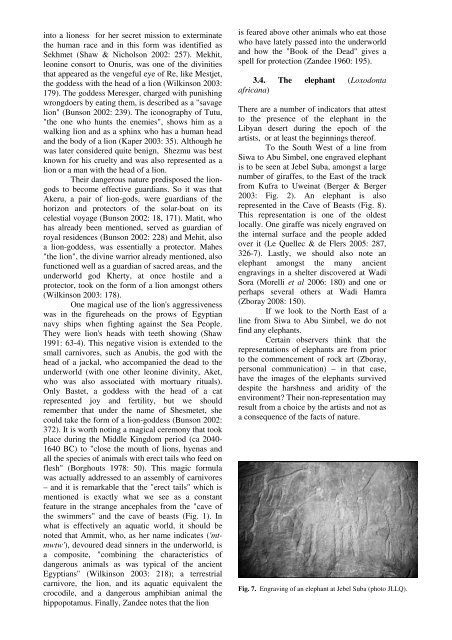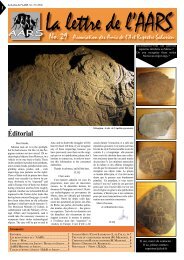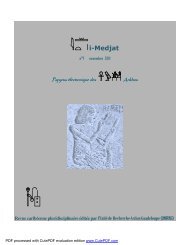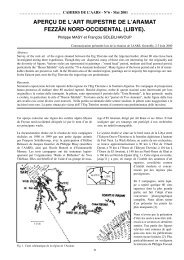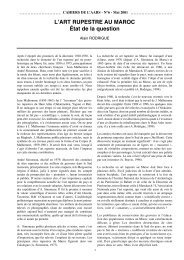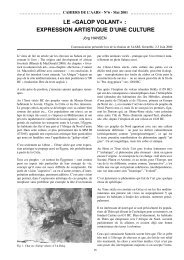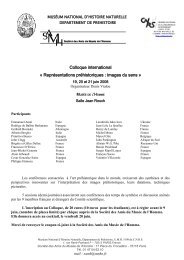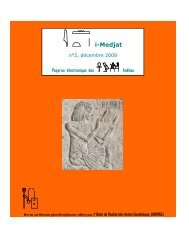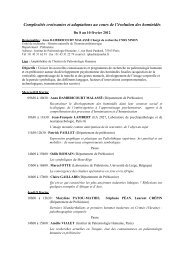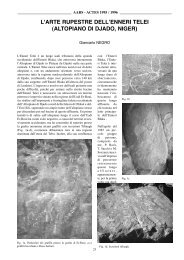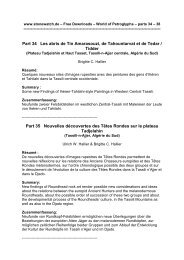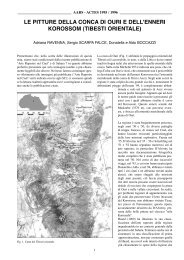From the Sahara to the Nile - Amis de l'Art rupestre saharien (AARS)
From the Sahara to the Nile - Amis de l'Art rupestre saharien (AARS)
From the Sahara to the Nile - Amis de l'Art rupestre saharien (AARS)
You also want an ePaper? Increase the reach of your titles
YUMPU automatically turns print PDFs into web optimized ePapers that Google loves.
in<strong>to</strong> a lioness for her secret mission <strong>to</strong> exterminate<br />
<strong>the</strong> human race and in this form was i<strong>de</strong>ntified as<br />
Sekhmet (Shaw & Nicholson 2002: 257). Mekhit,<br />
leonine consort <strong>to</strong> Onuris, was one of <strong>the</strong> divinities<br />
that appeared as <strong>the</strong> vengeful eye of Re, like Mestjet,<br />
<strong>the</strong> god<strong>de</strong>ss with <strong>the</strong> head of a lion (Wilkinson 2003:<br />
179). The god<strong>de</strong>ss Meresger, charged with punishing<br />
wrongdoers by eating <strong>the</strong>m, is <strong>de</strong>scribed as a "savage<br />
lion" (Bunson 2002: 239). The iconography of Tutu,<br />
"<strong>the</strong> one who hunts <strong>the</strong> enemies", shows him as a<br />
walking lion and as a sphinx who has a human head<br />
and <strong>the</strong> body of a lion (Kaper 2003: 35). Although he<br />
was later consi<strong>de</strong>red quite benign, Shezmu was best<br />
known for his cruelty and was also represented as a<br />
lion or a man with <strong>the</strong> head of a lion.<br />
Their dangerous nature predisposed <strong>the</strong> liongods<br />
<strong>to</strong> become effective guardians. So it was that<br />
Akeru, a pair of lion-gods, were guardians of <strong>the</strong><br />
horizon and protec<strong>to</strong>rs of <strong>the</strong> solar-boat on its<br />
celestial voyage (Bunson 2002: 18, 171). Matit, who<br />
has already been mentioned, served as guardian of<br />
royal resi<strong>de</strong>nces (Bunson 2002: 228) and Mehit, also<br />
a lion-god<strong>de</strong>ss, was essentially a protec<strong>to</strong>r. Mahes<br />
"<strong>the</strong> lion", <strong>the</strong> divine warrior already mentioned, also<br />
functioned well as a guardian of sacred areas, and <strong>the</strong><br />
un<strong>de</strong>rworld god Kherty, at once hostile and a<br />
protec<strong>to</strong>r, <strong>to</strong>ok on <strong>the</strong> form of a lion amongst o<strong>the</strong>rs<br />
(Wilkinson 2003: 178).<br />
One magical use of <strong>the</strong> lion's aggressiveness<br />
was in <strong>the</strong> figureheads on <strong>the</strong> prows of Egyptian<br />
navy ships when fighting against <strong>the</strong> Sea People.<br />
They were lion's heads with teeth showing (Shaw<br />
1991: 63-4). This negative vision is exten<strong>de</strong>d <strong>to</strong> <strong>the</strong><br />
small carnivores, such as Anubis, <strong>the</strong> god with <strong>the</strong><br />
head of a jackal, who accompanied <strong>the</strong> <strong>de</strong>ad <strong>to</strong> <strong>the</strong><br />
un<strong>de</strong>rworld (with one o<strong>the</strong>r leonine divinity, Aket,<br />
who was also associated with mortuary rituals).<br />
Only Bastet, a god<strong>de</strong>ss with <strong>the</strong> head of a cat<br />
represented joy and fertility, but we should<br />
remember that un<strong>de</strong>r <strong>the</strong> name of Shesmetet, she<br />
could take <strong>the</strong> form of a lion-god<strong>de</strong>ss (Bunson 2002:<br />
372). It is worth noting a magical ceremony that <strong>to</strong>ok<br />
place during <strong>the</strong> Middle Kingdom period (ca 2040-<br />
1640 BC) <strong>to</strong> "close <strong>the</strong> mouth of lions, hyenas and<br />
all <strong>the</strong> species of animals with erect tails who feed on<br />
flesh" (Borghouts 1978: 50). This magic formula<br />
was actually addressed <strong>to</strong> an assembly of carnivores<br />
– and it is remarkable that <strong>the</strong> "erect tails" which is<br />
mentioned is exactly what we see as a constant<br />
feature in <strong>the</strong> strange ancephales from <strong>the</strong> "cave of<br />
<strong>the</strong> swimmers" and <strong>the</strong> cave of beasts (Fig. 1). In<br />
what is effectively an aquatic world, it should be<br />
noted that Ammit, who, as her name indicates ('mtmwtw'),<br />
<strong>de</strong>voured <strong>de</strong>ad sinners in <strong>the</strong> un<strong>de</strong>rworld, is<br />
a composite, "combining <strong>the</strong> characteristics of<br />
dangerous animals as was typical of <strong>the</strong> ancient<br />
Egyptians" (Wilkinson 2003: 218); a terrestrial<br />
carnivore, <strong>the</strong> lion, and its aquatic equivalent <strong>the</strong><br />
crocodile, and a dangerous amphibian animal <strong>the</strong><br />
hippopotamus. Finally, Zan<strong>de</strong>e notes that <strong>the</strong> lion<br />
is feared above o<strong>the</strong>r animals who eat those<br />
who have lately passed in<strong>to</strong> <strong>the</strong> un<strong>de</strong>rworld<br />
and how <strong>the</strong> "Book of <strong>the</strong> Dead" gives a<br />
spell for protection (Zan<strong>de</strong>e 1960: 195).<br />
3.4. The elephant (Loxodonta<br />
africana)<br />
There are a number of indica<strong>to</strong>rs that attest<br />
<strong>to</strong> <strong>the</strong> presence of <strong>the</strong> elephant in <strong>the</strong><br />
Libyan <strong>de</strong>sert during <strong>the</strong> epoch of <strong>the</strong><br />
artists, or at least <strong>the</strong> beginnings <strong>the</strong>reof.<br />
To <strong>the</strong> South West of a line from<br />
Siwa <strong>to</strong> Abu Simbel, one engraved elephant<br />
is <strong>to</strong> be seen at Jebel Suba, amongst a large<br />
number of giraffes, <strong>to</strong> <strong>the</strong> East of <strong>the</strong> track<br />
from Kufra <strong>to</strong> Uweinat (Berger & Berger<br />
2003: Fig. 2). An elephant is also<br />
represented in <strong>the</strong> Cave of Beasts (Fig. 8).<br />
This representation is one of <strong>the</strong> ol<strong>de</strong>st<br />
locally. One giraffe was nicely engraved on<br />
<strong>the</strong> internal surface and <strong>the</strong> people ad<strong>de</strong>d<br />
over it (Le Quellec & <strong>de</strong> Flers 2005: 287,<br />
326-7). Lastly, we should also note an<br />
elephant amongst <strong>the</strong> many ancient<br />
engravings in a shelter discovered at Wadi<br />
Sora (Morelli et al 2006: 180) and one or<br />
perhaps several o<strong>the</strong>rs at Wadi Hamra<br />
(Zboray 2008: 150).<br />
If we look <strong>to</strong> <strong>the</strong> North East of a<br />
line from Siwa <strong>to</strong> Abu Simbel, we do not<br />
find any elephants.<br />
Certain observers think that <strong>the</strong><br />
representations of elephants are from prior<br />
<strong>to</strong> <strong>the</strong> commencement of rock art (Zboray,<br />
personal communication) – in that case,<br />
have <strong>the</strong> images of <strong>the</strong> elephants survived<br />
<strong>de</strong>spite <strong>the</strong> harshness and aridity of <strong>the</strong><br />
environment? Their non-representation may<br />
result from a choice by <strong>the</strong> artists and not as<br />
a consequence of <strong>the</strong> facts of nature.<br />
Fig. 7. Engraving of an elephant at Jebel Suba (pho<strong>to</strong> JLLQ).


